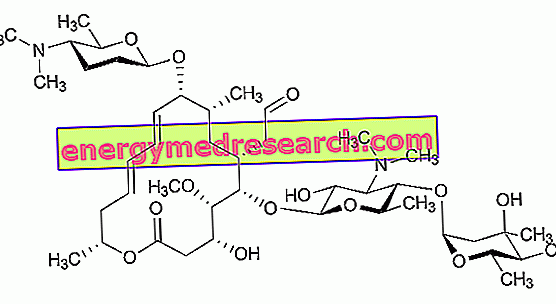Spiramycin is an antibiotic belonging to the class of macrolides and is isolated from cultures of Streptomyces ambofaciens .

Spiramycin - Chemical Structure
Indications
For what it uses
Spiramycin is used to treat infections caused by bacteria that are sensitive to it.
More particularly, spiramycin is indicated for the treatment of:
- Oral cavity infections;
- Respiratory tract infections, such as nasopharyngitis, laryngitis, otitis media, bronchitis, bronchopneumonia, pneumonia, etc .;
- Soft tissue infections;
- Gonorrhea;
- Erysipelas;
- Exanthematic diseases.
Warnings
During treatment with spiramycin - especially if done at high doses and for long periods of time - regular checks of blood counts and liver function should be performed.
In patients with glucose 6-phosphate dehydrogenase deficiency, some cases of acute hemolytic anemia have been reported following the use of spiramycin. Therefore, the use of the drug by this category of patients is not recommended.
Interactions
Concomitant use of spiramycin and levodopa (a drug used in the treatment of Parkinson's disease) may result in reduced absorption of the latter. Therefore - if co-administration of the two drugs is inevitable - a dose adjustment of levodopa administered may be necessary.
It is possible that cross-resistance between spiramycin and erythromycin (the progenitor of the class of macrolides), other macrolides or other drugs with a similar chemical structure may occur.
In any case, you must inform your doctor if you are taking - or have recently been taken - drugs of any kind, including non-prescription medicines and herbal and / or homeopathic products.
Side effects
Spiramycin can induce various types of side effects, although not all patients experience them. This depends on the different sensitivity that each person has towards the drug. Therefore, it is not said that the undesirable effects are all manifested with the same intensity in each individual.
Below are the main adverse effects that may occur during spiramycin treatment.
Gastrointestinal disorders
Spiramycin therapy may cause nausea, vomiting and diarrhea. Furthermore - although rarely - pseudomembranous colitis may occur which usually occurs with severe diarrhea and is caused by a superinfection with Clostridium difficile (a bacteria normally present in human bacterial flora).
Allergic reactions
Spiramycin, like any other drug, can cause allergic reactions in sensitive individuals. These reactions can occur in the form of:
- Skin rash;
- Urticaria;
- Itch;
- Angioedema;
- Anaphylactic shock.
More rarely, Henoch-Schönlein vasculitis and purpura may occur.
Hepatobiliary disorders
Treatment with spiramycin may cause changes in liver function and cholestatic and mixed hepatitis.
Blood and lymphatic system disorders
Spiramycin therapy can promote the onset of acute hemolytic anemia, especially in patients with a deficiency of the enzyme 6-phosphate dehydrogenase.
Nervous system disorders
Transient paraesthesia may occur during treatment with spiramycin.
Overdose
In the case of spiramycin overdose there is no real antidote, therefore, the treatment is purely symptomatic and supportive.
If you suspect you have taken an overdose of antibiotic, you must contact your doctor immediately and go to the nearest hospital.
Action mechanism
Spiramycin performs its antibiotic action by interfering with the synthesis of bacterial proteins.
The protein synthesis inside the bacterial cells takes place thanks to particular organelles called ribosomes.
Ribosomes consist of ribosomal RNA and proteins associated with each other to form two subunits:
- The 30S subunit, consisting of 21 proteins and one RNA molecule (16S);
- The 50S subunit, consisting of 34 proteins and two RNA molecules (23S and 5S).
The task of these organelles is to bind and translate the messenger RNA that comes from the cell nucleus and to synthesize the proteins for which it encodes.
Spiramycin binds to the 23S ribosomal RNA molecule present within the 50S subunit.
The binding of spiramycin with RNA 23S prevents the RNA itself from completing protein synthesis, thereby inhibiting bacterial cell growth.
Mode of Use - Posology
Spiramycin is available for oral administration in the form of tablets coated with 3, 000, 000 IU
The tablets should be taken whole, without chewing and with a generous amount of water.
Following are some indications on the doses of drug usually used in therapy.
Adults
In adults, the dose of spiramycin usually administered is two or three tablets, to be divided into two or three administrations.
children
In children, the dose of spiramycin usually administered is 150, 000-225, 000 IU / kg of body weight, to be divided into three or four administrations. Treatment with the antibiotic must then continue for at least 48 hours after the symptoms of the infection have disappeared.
The amount of drug administered varies according to the severity of the infection to be treated.
Patients with reduced liver function
Since spiramycin is only minimally excreted via the kidneys, adjustments of the doses of medication usually administered are not necessary in this category of patients.
Pregnancy and breastfeeding
There are no studies that accurately determine the safety of using spiramycin during pregnancy. Therefore, the use of this drug by pregnant women should be carried out only in cases of absolute necessity and only under the strict control of the doctor.
Since spiramycin is excreted in breast milk, the use of the antibiotic by breastfeeding mothers is contraindicated and should be avoided.
Contraindications
The use of spiramycin is contraindicated in the following cases:
- In patients with known hypersensitivity to spiramycin or other macrolides;
- During breastfeeding.



